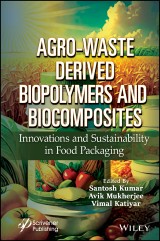Details
Agro-Waste Derived Biopolymers and Biocomposites
Innovations and Sustainability in Food Packaging1. Aufl.
|
173,99 € |
|
| Verlag: | Wiley |
| Format: | |
| Veröffentl.: | 30.04.2024 |
| ISBN/EAN: | 9781394175154 |
| Sprache: | englisch |
| Anzahl Seiten: | 480 |
DRM-geschütztes eBook, Sie benötigen z.B. Adobe Digital Editions und eine Adobe ID zum Lesen.
Beschreibungen
<b>AGRO-WASTE DERIVED BIOPOLYMERS AND BIOCOMPOSITES</b> <p> <b>This comprehensive book describes the fundamental principles and major advancements in the utilization of agro-waste for deriving biopolymers, and their applications to fabricate composite, nanocomposite, and hybrid food packaging films and coatings.</b> <p>The book serves as a complete, systematic, comprehensive account of the contemporary developments in the area of novel and environment-friendly valorization of agro- and food wastes into value-added products like biodegradable polymer and active functional agents for food packaging applications. It also describes the hurdles and challenges in the commercialization of these novel biopolymer-based materials, including their composites, their applications, safety, and legal ramifications. <p>This book consists of fifteen chapters covering different aspects of agro- and food waste utilization, the development of biodegradable polymers, and their composites for sustainable food packaging applications. The first thirteen chapters detail the processing of various agro- and food wastes of plant and animal origin to synthesize different biopolymers, such as starch, cellulose, chitosan, silk proteins, pectin, etc., and their applications for the fabrication of sustainable food packaging materials and composites that are attractive alternatives to synthetic plastic packaging. These chapters also summarize the effectiveness of these biopolymers and their composites in developing active films and edible coatings for shelf-life extension and preservation of perishable foods. <p>A chapter is devoted to issues of biodegradability, including analyses of various biodegradation reactions, such as depolymerization, mineralization, biochemical, and abiotic degradation both in soil and aquatic environments. The book concludes with a chapter addressing the concerns associated with the possible migration of components or additives from these biodegradable packaging into packaged food items. <p><b>Audience</b> <p>The primary audience for this book is researchers, scientists, and engineers working in food science and technology, food engineering and technology, food biotechnology, sustainable food packaging, etc. Additionally, food entrepreneurs and associated businesses, such as the packaging and coatings industries, will also have a keen interest in the book.
<p><b>Santosh Kumar, PhD, </b> is an assistant professor in the Department of Food Engineering and Technology, Central Institute of Technology, Kokrajhar, India. He has authored 30+ peer-reviewed journal papers, multiple book chapters, and edited two books. His research experience is in the area of sustainable food packaging and preservation. <p><b>Avik Mukherjee, PhD, </b> is an associate professor in the Department of Food Engineering and Technology, Central Institute of Technology, Kokrajhar, India. He has co-authored and co-edited 6 books. His current research interests focus on the application of natural and novel food preservation and packaging technologies, including biopolymer-based food packaging and the application of nanotechnology in sustainable food preservation and packaging. <p><b>Vimal Katiyar, PhD, </b> is a professor in the Department of Chemical Engineering, Indian Institute of Technology, Guwahati, India. He received a PhD in chemical engineering from the Indian Institute of Technology, Bombay, India. His main area of research includes sustainable polymer development, its processing, its structure-property relationship, rheological aspects, migration studies, toxicological effects, polymer degradation, polymer-based nanomaterials, food packaging, and clean and green energy technologies. He is the co-inventor of 29 granted patents, published 140+ peer-reviewed research articles, and 70 book chapters.
<p> <b>This comprehensive book describes the fundamental principles and major advancements in the utilization of agro-waste for deriving biopolymers, and their applications to fabricate composite, nanocomposite, and hybrid food packaging films and coatings.</b> <p>The book serves as a complete, systematic, comprehensive account of the contemporary developments in the area of novel and environment-friendly valorization of agro- and food wastes into value-added products like biodegradable polymer and active functional agents for food packaging applications. It also describes the hurdles and challenges in the commercialization of these novel biopolymer-based materials, including their composites, their applications, safety, and legal ramifications. <p>This book consists of fifteen chapters covering different aspects of agro- and food waste utilization, the development of biodegradable polymers, and their composites for sustainable food packaging applications. The first thirteen chapters detail the processing of various agro- and food wastes of plant and animal origin to synthesize different biopolymers, such as starch, cellulose, chitosan, silk proteins, pectin, etc., and their applications for the fabrication of sustainable food packaging materials and composites that are attractive alternatives to synthetic plastic packaging. These chapters also summarize the effectiveness of these biopolymers and their composites in developing active films and edible coatings for shelf-life extension and preservation of perishable foods. <p>A chapter is devoted to issues of biodegradability, including analyses of various biodegradation reactions, such as depolymerization, mineralization, biochemical, and abiotic degradation both in soil and aquatic environments. The book concludes with a chapter addressing the concerns associated with the possible migration of components or additives from these biodegradable packaging into packaged food items. <p><b>Audience</b> <p>The primary audience for this book is researchers, scientists, and engineers working in food science and technology, food engineering and technology, food biotechnology, sustainable food packaging, etc. Additionally, food entrepreneurs and associated businesses, such as the packaging and coatings industries, will also have a keen interest in the book.


















